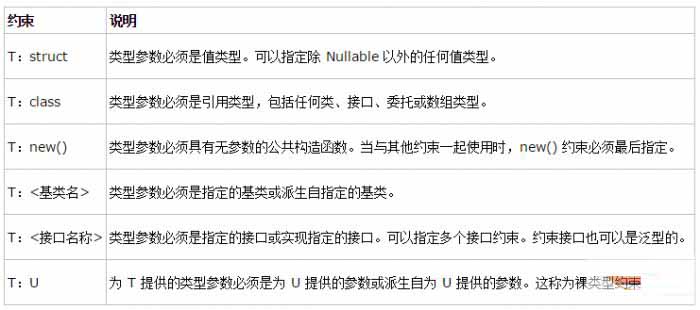C#基础系列:小话泛型
作者:网络转载 发布时间:[ 2016/3/4 10:58:52 ] 推荐标签:.NET 测试开发技术
3、泛型的使用:
(1)泛型方法的使用:这也是博主使用多的用法之一,像这种泛型方法一般是一些static的通用方法,例如原来项目中用到的一个将DataGridViewRow对象转换成对应的实体Model的方法如下:
public static T ToObject<T>(DataGridViewRow item) where T:class
{
var model = item.DataBoundItem as T;
if (model != null)
return model;
var dr = item.DataBoundItem as System.Data.DataRowView;
model = (T)typeof(T).GetConstructor(new System.Type[] { }).Invoke(new object[] { });
//反射得到泛型类的实体
PropertyInfo[] pro = typeof(T).GetProperties(BindingFlags.Instance | BindingFlags.Public);
Type type = model.GetType();
foreach (PropertyInfo propertyInfo in pro)
{
if (Convert.IsDBNull(dr[propertyInfo.Name]))
{
continue;
}
if (!string.IsNullOrEmpty(Convert.ToString(dr[propertyInfo.Name])))
{
var propertytype = propertyInfo.PropertyType;
if (propertytype == typeof(System.Nullable<DateTime>) || propertytype == typeof(DateTime))
{
type.GetProperty(propertyInfo.Name).SetValue(model, Convert.ToDateTime(dr[propertyInfo.Name]), null);
}
else if (propertytype == typeof(System.Nullable<decimal>) || propertytype == typeof(decimal))
{
type.GetProperty(propertyInfo.Name).SetValue(model, Convert.ToDecimal(dr[propertyInfo.Name]), null);
}
else if (propertytype == typeof(System.Nullable<int>) || propertytype == typeof(int))
{
type.GetProperty(propertyInfo.Name).SetValue(model, Convert.ToInt32(dr[propertyInfo.Name]), null);
}
else if (propertytype == typeof(System.Nullable<double>) || propertytype == typeof(double))
{
type.GetProperty(propertyInfo.Name).SetValue(model, Convert.ToDouble(dr[propertyInfo.Name]), null);
}
else
{
type.GetProperty(propertyInfo.Name).SetValue(model, dr[propertyInfo.Name], null);
}
}
}
return model;
}
使用泛型方法的注意事项:
泛型方法的重载:public void Fun1<T>(T a);和public void Fun1<U>(U a);是无法重载的,这其实很好理解,因为T和U其实都是泛型的一个代表符号而已;
泛型方法的重写:下面的方法重写FuncA的重写是正确的,FuncB的重写不正确,因为约束被默认继承,不用再写。
abstract class BaseClass
{
public abstract T FuncA<T,U>(T t,U u) where U:T;
public abstract T FuncB<T>(T t) where T:IComparable;
}
class ClassA:BaseClass
{
public override X FuncA<X,Y>(X x,Y y){...}
public override T FuncB<T>(T t) where T:IComparable{...}
}
(2)泛型类的使用:
public class Class_Base<DTO, T>
{}
使用这个类的时候必须要指定两个泛型类。
(3)泛型接口以及泛型继承的使用:
泛型接口的类型参数要么已实例化,要么来源于实现类声明的类型参数
public interface Interface_Base<T>
{}
public class Class_Base<DTO, T> : Interface_Base<DTO>
{}
DTO来源于实现类Class_Base
(4)泛型委托的使用:其实这种用法博主真的用得很少,只是原来见到过大牛们类似的代码。
定义泛型委托:
public delegate void MyDelegate<T>(T obj);
泛型委托的使用:
public delegate void MyDelegate<T>(T obj);
static void Main(string[] args)
{
var method = new MyDelegate<int>(printInt);
method(1);
Console.ReadKey();
}
static void printInt(int i)
{
Console.WriteLine(i);
}
(5)泛型约束:用来约束泛型类型有那些特性。常见的泛型约束也那么几类:
泛型约束的格式
public class Imps_Base<DTO, T> : Ifs_Base<DTO>
where T : BaseEntity
where DTO : class
{
}

本文内容不用于商业目的,如涉及知识产权问题,请权利人联系SPASVO小编(021-61079698-8054),我们将立即处理,马上删除。
相关推荐

更新发布
功能测试和接口测试的区别
2023/3/23 14:23:39如何写好测试用例文档
2023/3/22 16:17:39常用的选择回归测试的方式有哪些?
2022/6/14 16:14:27测试流程中需要重点把关几个过程?
2021/10/18 15:37:44性能测试的七种方法
2021/9/17 15:19:29全链路压测优化思路
2021/9/14 15:42:25性能测试流程浅谈
2021/5/28 17:25:47常见的APP性能测试指标
2021/5/8 17:01:11热门文章
常见的移动App Bug??崩溃的测试用例设计如何用Jmeter做压力测试QC使用说明APP压力测试入门教程移动app测试中的主要问题jenkins+testng+ant+webdriver持续集成测试使用JMeter进行HTTP负载测试Selenium 2.0 WebDriver 使用指南














 sales@spasvo.com
sales@spasvo.com